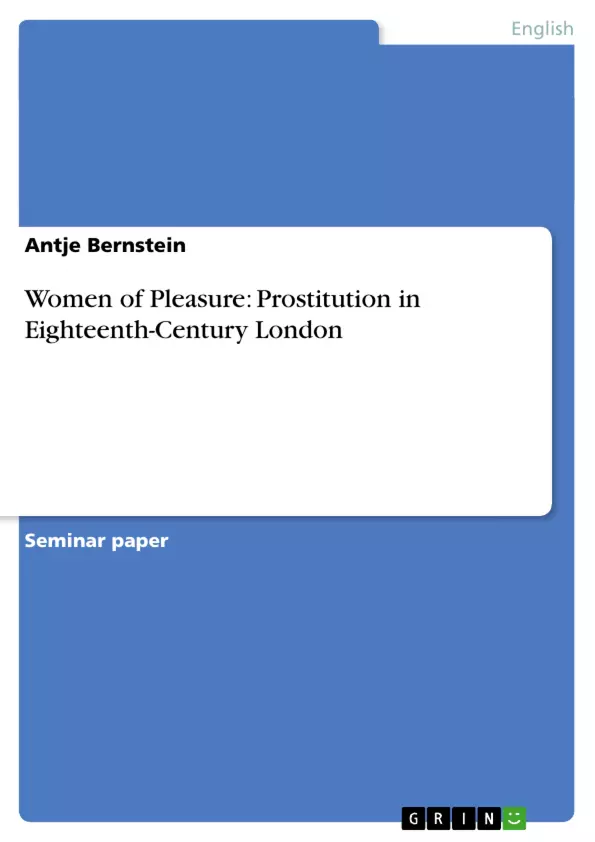On the threshold of industrialisation many significant changes took place in England throughout the eighteenth century. Trade and economy grew more and more and consequently trade centres like London became metropolises to which many people moved to from rural areas due to the bigger chance to find a job there. The society in such cities was dominated by men and there was no equality of the sexes as women were considered to be inferior and dependent on men. They had to obey their fathers or husbands, who made all decisions for them and they had no own property as everything they had belonged to their husbands1. But there were women who tried to escape the subordinate role they possessed. Expected to be virtuous housewives, mothers and wives, who obey their husbands unconditionally, some women led totally different lives. Instead of marrying, bringing up children and doing the household they worked to earn their living. But whereas many women chose to work as servants or seamstresses, the business of some other young ladies was of a totally different nature – of a disorderly nature. They earned their money by offering sexual services in exchange for money. In other words they worked as prostitutes. Especially London was a city where this sexual trade was very widespread due to the constantly arriving tradesmen and sailors who were willing to pay women to satisfy their needs. But who were these women of pleasure? Why did they work as prostitutes and how did they live? To answer these questions it is necessary to look at the lives of these women in detail.
Their social backgrounds and their education can be considered as the origin of their later work as harlots. As people cannot only be characterised by what they do themselves but by the opinions of the people around them as well, it is important to consider the reactions of society towards prostitutes. And last but not least the living and working conditions of streetwalkers as well as the risks they had to face in their everyday lives are worth consideration. [...]
Inhaltsverzeichnis (Table of Contents)
- Introduction
- Social background
- Origin
- Education and Apprenticeship
- Turn to Prostitution
- Causes
- Opinions of Society
- The Life of a Woman of Pleasure
- Working and Living Conditions
- Pregnancy and Diseases
- Repentance and Punishment
- Conclusion
Zielsetzung und Themenschwerpunkte (Objectives and Key Themes)
This academic assignment aims to explore the lives of women working as prostitutes in eighteenth-century London, shedding light on their social backgrounds, motivations, and the realities of their work and life. The text delves into the social context of prostitution, examining societal attitudes towards these women and the pressures that led them to engage in this profession.
- The social origins and backgrounds of women in prostitution
- Factors contributing to their decision to become prostitutes
- The perspectives and reactions of society towards prostitution
- The working and living conditions experienced by prostitutes
- The risks and challenges faced by these women in their daily lives
Zusammenfassung der Kapitel (Chapter Summaries)
- Introduction: The introduction sets the scene by outlining the social and economic context of eighteenth-century England, highlighting the growth of London as a bustling metropolis and the patriarchal societal structures that defined women's roles. It introduces the topic of prostitution and the motivations for studying it, emphasizing the need to understand the lives of these women in detail.
- Social background: This chapter explores the diverse social origins of prostitutes, focusing on their family backgrounds, childhood experiences, and socioeconomic status. It highlights the prevalence of poverty, abandonment, and limited opportunities for these women. The chapter draws upon fictional accounts like Moll Flanders to provide insights into the realities of the lives of young women who were forced to navigate difficult circumstances.
- Turn to Prostitution: This section delves into the reasons why women turned to prostitution, exploring the pressures and circumstances that led them to engage in this profession. It examines the role of poverty, lack of education and employment opportunities, and societal expectations in shaping their choices. The chapter also examines the opinions of society towards these women, revealing the prevalent stigma and judgment associated with prostitution.
- The Life of a Woman of Pleasure: This chapter focuses on the daily lives of prostitutes, examining their working conditions, the challenges they faced, and the risks associated with their profession. It explores the prevalence of sexually transmitted diseases, the threat of pregnancy, and the constant fear of punishment and exploitation. The chapter provides a glimpse into the realities of their lives, highlighting the hardships and vulnerabilities they endured.
Schlüsselwörter (Keywords)
This text explores the complex world of prostitution in eighteenth-century London, focusing on the lives of women who engaged in this profession. Key concepts include the social backgrounds and education of prostitutes, the factors that led them to turn to prostitution, societal attitudes towards them, and the realities of their working and living conditions. The study draws upon historical accounts, fictional narratives, and scholarly works to understand the complexities of prostitution and the lives of women who were forced to navigate this challenging world.
- Citation du texte
- Antje Bernstein (Auteur), 2005, Women of Pleasure: Prostitution in Eighteenth-Century London, Munich, GRIN Verlag, https://www.grin.com/document/71335



